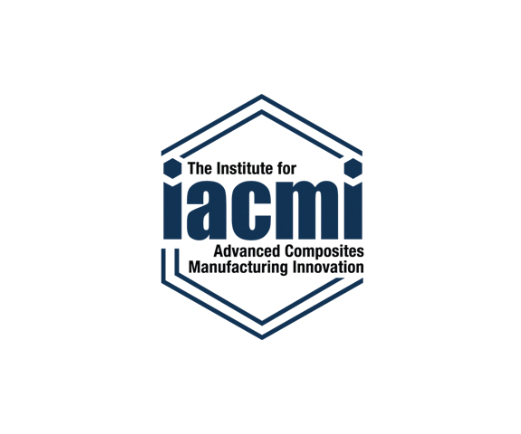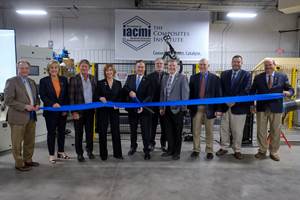Developing new solutions to multimaterial joining
Several recent IACMI partner projects focus on technology innovation related to challenges in multimaterial joining for the wind and automotive sectors.

The IACMI — The Composites Institute (Knoxville, Tenn., U.S.) project model focuses research and development on technology innovation considered within the most likely path for deployment and impact. IACMI and its partners are creating new materials and processes for addressing key industry challenges, including multimaterial joining.
The ability to join composites to other materials is a crucial manufacturing-enabling technology for the integration of advanced composites into wind turbine blades, vehicles and other high-value applications. Benefits are numerous:
- Lightweighting — via mixed-material product design — improves the energy efficiency and sustainability of end-use applications. Automotive manufacturers regularly use mixed-material design approaches as a strategy to reduce mass without imposing significant technology implementation risk. Lighter vehicles enable reductions in fuel consumption and greenhouse gas emissions.
- Multimaterial joining techniques can improve manufacturing process flexibility and reduce production costs. Longer wind turbine blades are more difficult to transport from factory to installation site. As highway transportation for wind turbine blades becomes increasingly impractical, novel multimaterial joining techniques could enable larger and more efficient blades via jointed designs that provide for on-site manufacture and assembly.
- Improved assembly/disassembly characteristics can enhance product lifecycle characteristics and satisfy end-of-life (EOL) recyclability or circularity goals. Automakers are increasingly designing vehicles for easy and economic disassembly, due in part to a global shift in favor of sustainability initiatives such as the European Union’s End-of-Life-Vehicle Directive, which requires that 85% (by weight) of materials used in passenger vehicles be reusable or recyclable. Improved assembly/disassembly characteristics can enable life-extending refurbishment and replacement of parts as well as the recovery and reuse of EOL products.
IACMI’s technology roadmap includes project topic areas that prioritize project focus and will advance the state of multimaterial joining technologies across the composites manufacturing industry in the following ways:
- Novel multimaterial joining techniques including mechanical, adhesive, and welding-based approaches are increasingly attractive as the cost of carbon fiber continues to decline.
- Robust sensing and inspection methods are essential to assessing the integrity, repairability and producibility of multimaterial composite joints in key lightweighting applications.
- Reliable design tools and test methods help ensure that novel multimaterial joining techniques are sufficiently cost-effective and dependable to achieve design compliance, serviceability and EOL requirements of key applications.
To address these topic areas, IACMI is supporting the development of novel non-adhesive multimaterial joining methods. For example, one project team is validating a non-adhesive thermal welding approach for joining wind turbine components without the need for adhesives. The project team consists of Arkema (King of Prussia, Pa., U.S.), Nippon Electric Glass (Otsu, Japan), Saertex (Saerbeck, Germany), General Electric (Boston, Mass., U.S.), TPI Composites (Scottsdale, Ariz., U.S.), the University of Tennessee (UT, Knoxville, Tenn., U.S.) and the National Renewable Energy Laboratory (NREL, Golden, Colo., U.S.).
Adhesive joining is a multi-step method that, if not properly executed, can cause manufacturing defects and subsequent failures in the blade structure. The novelty of Arkema’s thermal welding approach is its use of thermoplastic resins to replace incumbent thermosetting epoxies. Thermoplastics can be bonded at room temperature and do not require heat input like thermosetting bonds, thus reducing energy requirements and manufacturing costs.
IACMI is demonstrating surface treatment techniques to enhance bond integrity/uniformity.
Unlike thermosets, bonding thermoplastics via thermal welding may eliminate highly stressed bond lines and the need for additional adhesive bonding materials between blade components, which reduces costs and blade manufacturing cycle time. Thermoplastic resins are also easier to recycle, as both manufacturing scrap and EOL components can be heated, recovered and reused for new wind turbines or other composites applications. Additionally, IACMI is demonstrating surface treatment techniques to enhance bond integrity/uniformity.
Surface conditioning technologies, such as ultraviolet ozone (UVO) and oxygen plasma, are often used to clean composite substrates and increase surface energy to ensure strong, durable bonding of fiber-reinforced composite joints. IACMI has commissioned two plasma-based surface treatment technologies to support member projects: one at the U.S. Department of Energy’s Manufacturing Demonstration Facility at Oak Ridge National Laboratory (ORNL, Knoxville, Tenn., U.S.), and another at IACMI’s Scale-Up Research Facility (SURF) in Detroit, Mich., U.S., which is managed by Michigan State University (East Lansing).
For this project, PPG Industries (Chestwick, Pa., U.S.) and Michigan State University studied new adhesives and coatings that allow OEMs to use their existing automotive assembly lines to integrate structural carbon fiber-reinforced polymers (CFRPs) into mixed-material designs. In this process, structural vehicle bodies are assembled on existing assembly lines and passed through a paint shop, where they are electrocoated and baked in an oven to improve the strength, corrosion resistance and durability of the finish. High oven temperatures — especially for mixed-material designs — can induce stresses and failures due to thermal expansion between coatings and substrate materials and between joined components. The team’s investigation of new prototype adhesives established a deeper understanding of the importance of surface treatment technologies for ensuring proper structural adhesive bonding of composites to dissimilar materials.
Related Content
People in composites: April 2023
Concordia Engineered Fibers, Nawa Technologies, IACMI, Joby Aviation and Akarmak America have made new personnel announcements in April 2023.
Read MoreIACMI receives funding renewal from U.S. DOE to continue composites R&D
Over the next five years, IACMI aims to further composites R&D efforts to support U.S. decarbonization and its pillars: technology, economy and workforce development.
Read MoreRead Next
All-recycled, needle-punched nonwoven CFRP slashes carbon footprint of Formula 2 seat
Dallara and Tenowo collaborate to produce a race-ready Formula 2 seat using recycled carbon fiber, reducing CO2 emissions by 97.5% compared to virgin materials.
Read MoreVIDEO: High-volume processing for fiberglass components
Cannon Ergos, a company specializing in high-ton presses and equipment for composites fabrication and plastics processing, displayed automotive and industrial components at CAMX 2024.
Read MoreDeveloping bonded composite repair for ships, offshore units
Bureau Veritas and industry partners issue guidelines and pave the way for certification via StrengthBond Offshore project.
Read More



















